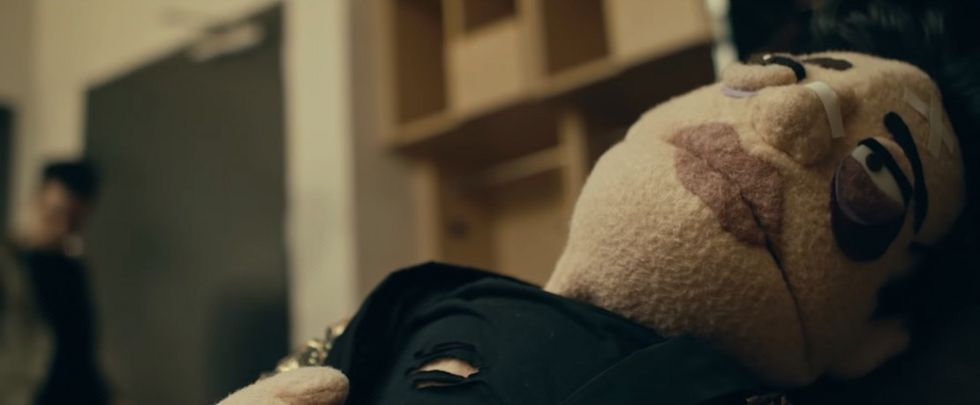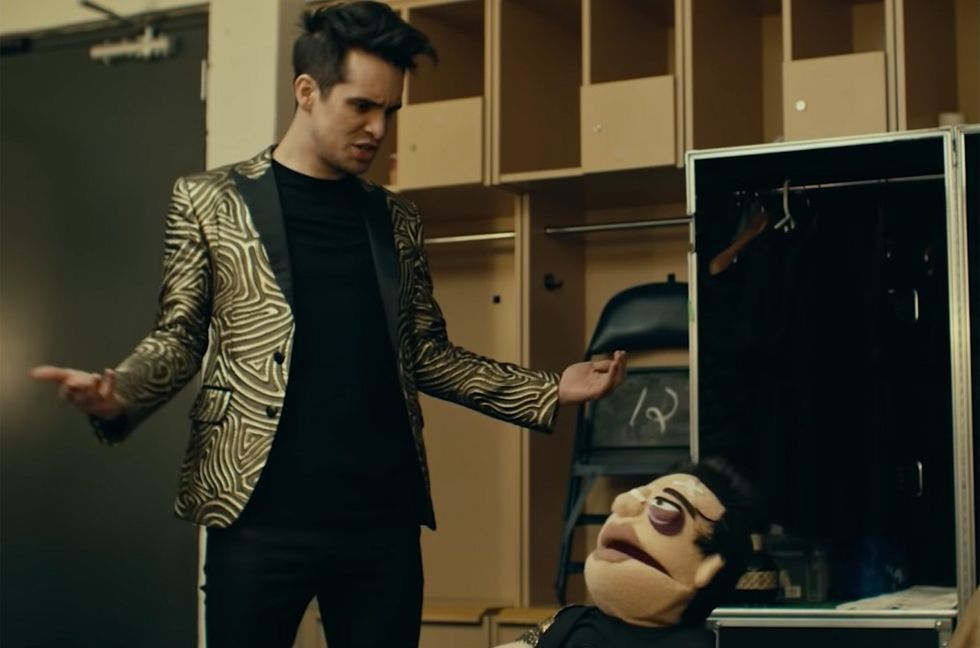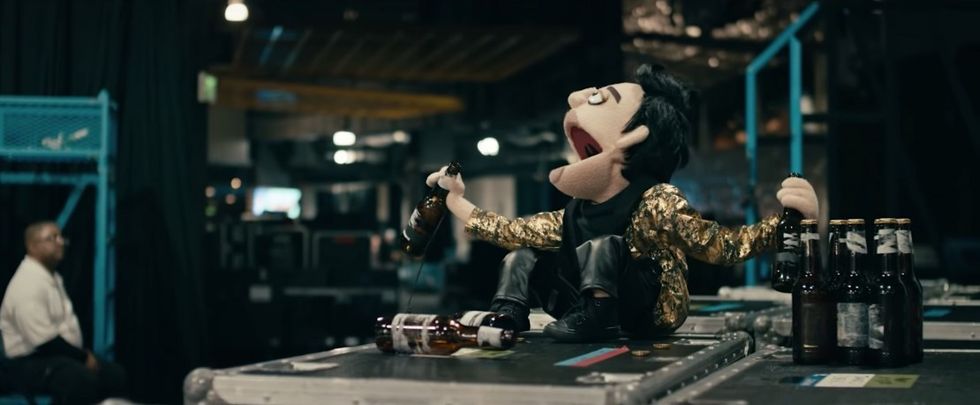How to Make a Live Music Video for Panic! at the Disco (with Puppets)
If you think planning, shooting, and editing a live music video is challenging, imagine throwing puppets into the mix.
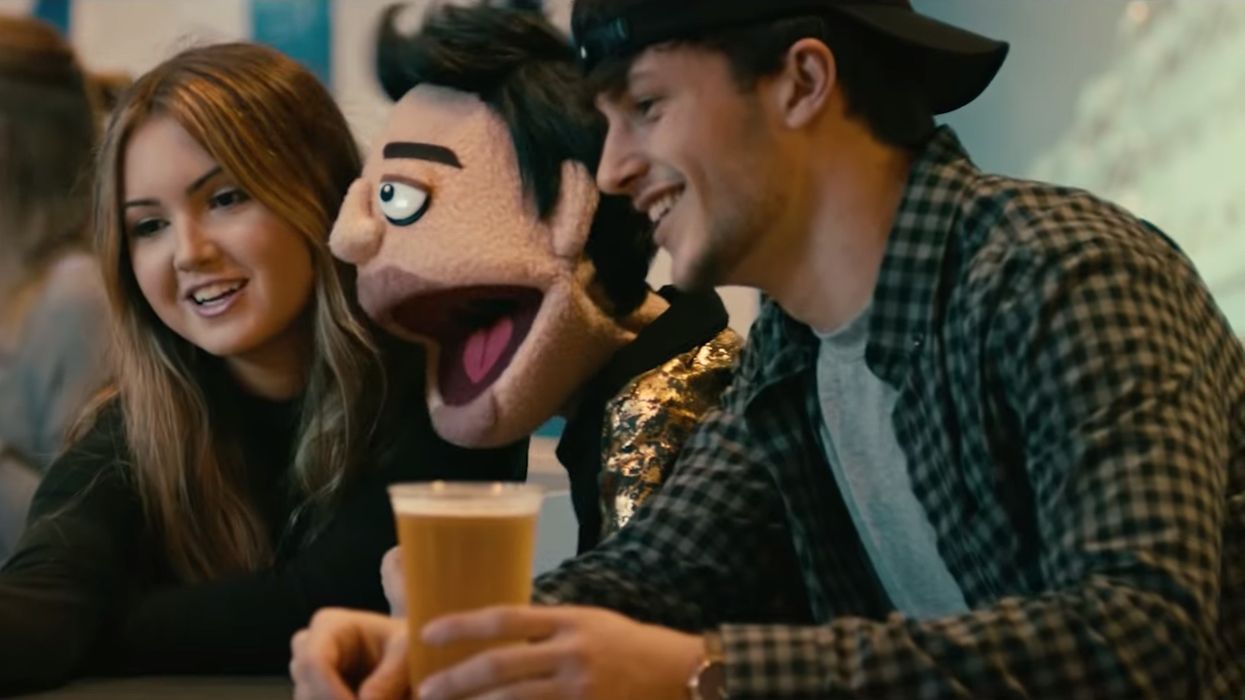
In Panic! At The Disco’s recent music video for Dancing’s Not A Crime, Beebo the puppet returns to live out his dream with a VIP pass to the P!ATD concert, getting trashed, partying with concert-goers, and ultimately getting thrown out by security.
Other than being a hilariously entertaining music video, "Dancing's Not a Crime" is a testament to how filmmakers can make overcome major obstacles with planning, creativity, and maybe a wish and a prayer.
We sat down with director Brandon Dermer, DP Wojciech Kielar, and colorist Ryan McNeal to talk about puppets, mixing elements of the docu-style genre with narrative, and their creative process.
NFS: What was your journey to becoming filmmakers and working on music videos?
Brandon Dermer: I'm a failed musician. I played in bands in high school, and I was always making sketches with my friends to promote the band and just for fun…the sketches were better than the music. I went to film school at Columbia College in Chicago, where my friends and I would make a short every month that we'd write, direct, star in, everything, and really cut our teeth doing that. After school, I moved out to LA, got five internships, one turned into a job and I was an assistant to a producer and a manager.
After four years of being an assistant, learning the business and writing nights and weekends, my bosses were like, "You've got to make something that showcases the cinematic eye that we know you have, and what you want to be doing." So I made a short film…really, a fake trailer for the dumbest movie idea I could think of but played it extremely straight. I tricked a lot of folks and took meetings about buying the film that didn’t exist. After that, being a failed musician and a guy who loves music, I thought the next best step would be to make a music video. So, there's this band called Futurecop! out in the UK, and I reached out to them and they were down, and we split the budget and made a music video. That was my first entry point into making music videos professionally.
Wojciech Kielar: I don't know when I initially chose filmmaking as a career path, but I guess it happened in high school when we had to choose a major for college. As an immigrant and first in my family to get a higher education in The States it was kind of a scary thing telling your parents you want to pursue art, but thankfully they were very supportive. I was accepted into Columbia College and I studied directing as a major my freshman year, but I soon realized that I wanted to be behind the camera. I studied cinematography there for four years and was able to shoot on 16mm, Super 16mm, and my final thesis film was shot on 35mm. After graduation, I was one of two students picked to do an internship on a major motion picture. In my case it was Oliver Stone’s W and I interned under Phedon Papamichael ASC.
Ryan McNeal: I also went to Columbia College and while I was studying directing there I was coloring my own stuff. I come from a Photoshop background. I did Photoshop retouching for years before film school. When the concept of color grading came up in our classes, I jumped right on it. When I moved out to LA, I applied to every post house that had job openings and got a job at Company 3 as an assistant. I worked there for several years, learned a lot, and once I felt like I had built up my client base, I left and started my own boutique post house and brought on my wife, Becky, as our producer.
NFS: How did you connect with Panic! At The Disco and start making music videos with them?
Dermer: The long answer is Nekrogobikon...A goblin metal band I discovered in 2012 and made them a music video for their song "No One Survives" which also then birthed their mascot John Goblikon. Diplo and his manager Kevin Kusatsu caught wind of the video and reached out to me. That led to me directing a Major Lazer video, "Scare Me", starring Terry Crews. From that, I did a music video for Dillon Francis called "Not Butter" that became a Vimeo Staff Pick and played at SXSW. Brendon Urie, a friend of Dillon’s, saw that and reached out to me, and we did a music video for a song for Panic! At The Disco’s track "Victorious", which got nominated for a VMA.
Dermer: About a year and a half later, he contacted me and asked, "Hey man, have you ever worked with puppets? I want to do a video about sort of the trajectory of my life in the music business, but through puppets." And I was like, "Yes dude, I actually have!” So I sent Brendon a pilot Wojciech and I did involving puppets for MTV, and then it was on, and we made "Hey Look Ma, I Made It".
NFS: A lot of this music video takes place in an uncontrolled live performance environment. What was your approach to planning and pre-production for this video? What was your plan for if you couldn’t get “the shot”?
Dermer: Brendon Urie and his manager, Scott Nagelberg, and I were talking about what else we could do with the Beebo [puppet] character that we've brought to life. We thought, "What if we took him out in the real world? What if we take this puppet and place him in the real world with an all-access pass to sold-out Panic! At The Disco concerts, sort of documentary style, and make it the ultimate wish fulfillment through Beebo’s fabric eyes?"
Dermer: We knew that we would have a very structured shot list but we always wanted to be open for jazz, because there are so many incredible things you just can't plan on happening in a live environment. Like for instance, this young girl ran up wearing her homemade Beebo jacket and I wanted to be able to roll and get that no matter what. We had to be ready for anything. So we basically shot listed the day around Panic! At The Disco’s setlist. Knowing certain songs we absolutely wanted to capture Beebo participating with, then blocking out “downtime” for jazz.
Kielar: With shoots like this, you're kind of at the mercy of the show. Brendon Urie and his team basically gave us free rein and allowed us to get whatever we needed, which was amazing. Also, lucky for us, we got to shoot two performances, the first in St. Louis and the second in Memphis. This was very helpful because if there was anything that we were not able to capture or didn’t get the exact way we wanted the 1st time around, we had a 2nd chance to shoot it in Memphis.
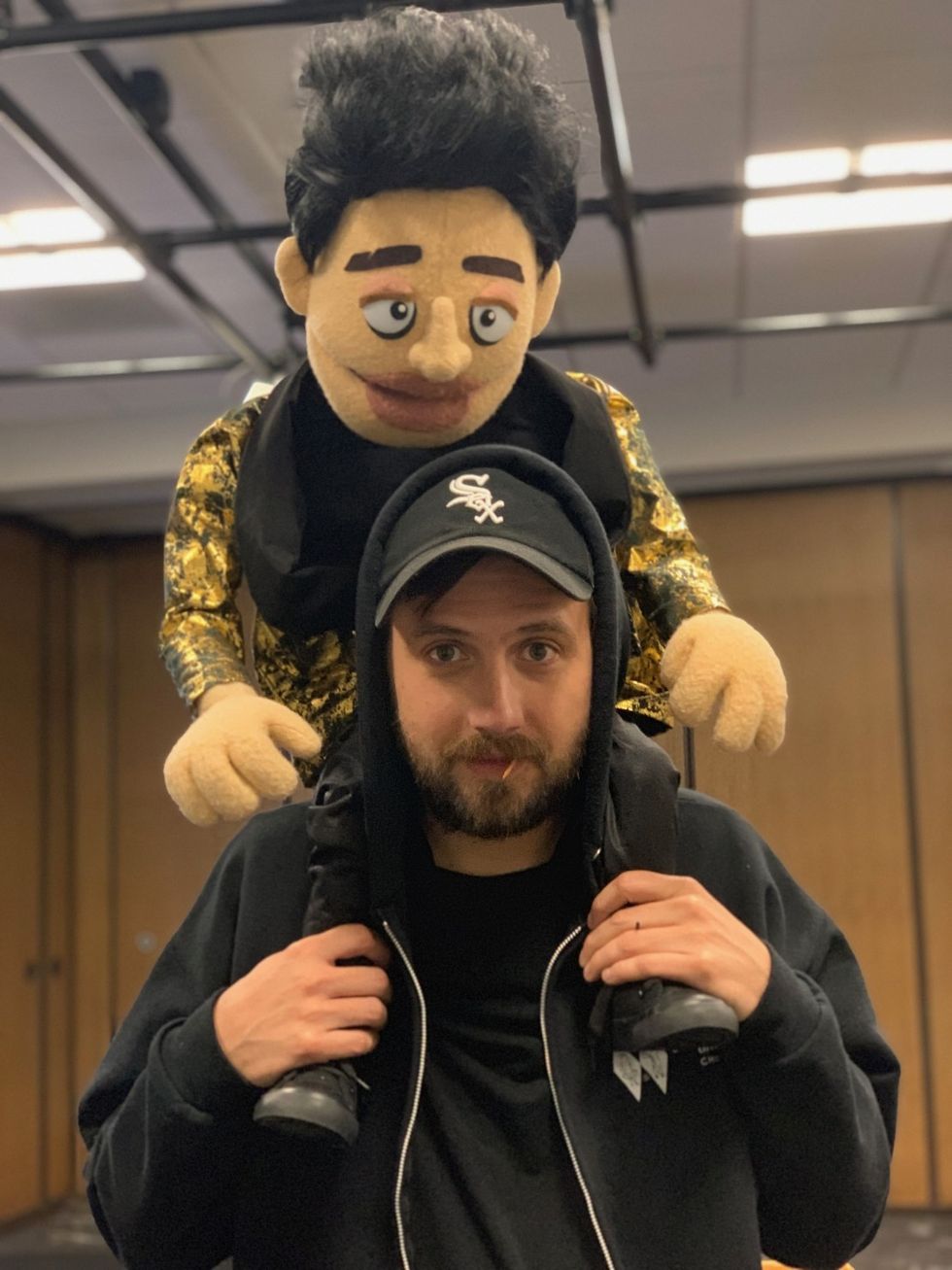
NFS: You shot on the Blackmagic URSA Mini Pro and the Blackmagic Pocket Cinema Camera 4K. Why did you decide to use those two cameras and how did you decide when to use them?
Kielar: This was technically a one-camera shoot. The URSA Mini Pro was our hero camera, and all shots featuring the puppet and Brandon were shot on it. We brought the Pocket Cinema Camera with us as an additional camera, in case we needed to be in two places at the same time, and we would have our AC/operator, Chuck Schwarzbeck capture those moments. This was the first project we shot entirely using these two cameras.
Dermer: Though the URSA Mini Pro was our A camera, the nice thing about having that Pocket Cinema Camera on a shoot like this goes back to what I said about the jazz, those unplanned moments. The Pocket Cinema Camera is so light and easy to use, so it was a great asset on a shoot like this.
Kielar: The URSA Mini Pro also has dual CFast card slots, which allowed me to roll a bit longer without swapping out cards. It also has the ability to record to SSD drives, which we actually considered doing on this music video, but since I’ve never done it before and I wasn't really comfortable with the workflow, we just ended up going with the CFast cards.
NFS: What can you tell us about working with the Blackmagic RAW codec in post-production?
McNeal: Both cameras shot Blackmagic RAW, and I only have good things to say about the codec. It performs really well, it plays back as you would expect ProRes to play back. It doesn't use a lot of GPU or CPU, which is really nice, you get your instantaneous 4K playback. I have a pretty beefy workstation, but in the case of the Blackmagic RAW, I looked at the activity monitor and there just wasn't a lot going on.
Kielar: Ryan colors in DaVinci Resolve, so it’s really nice that we were able to use the cameras made by the same people who make the software we use in post. Color, today more than ever, is an extension of cinematography, so a close working relationship with your colorist is very important. I always try to get the colorist the thickest negative possible and allow him the most amount of room to work in. It was great to hear Ryan’s positive feedback on the images as well as the capabilities offered to him from the Black Magic Raw format.
McNeal: Another thing that’s cool about the Blackmagic RAW codec is that it's also trim-able. I feel like a lot of colorists might not really use Resolve's trimming feature, but you can actually pair down the files. For instance, we have a 20-minute take and maybe there's a two-second clip from it that was actually used in the edit, you don't need that whole 20-minute segment in your Resolve project. So, I actually used Resolve to trim everything down. And when it trims, because Blackmagic RAW is a trim-able format, it can actually stay in its native codec without doing any transcoding.
NFS: Can you tell us about your color process and developing the look for "Dancing’s Not A Crime"?
McNeal: I usually sit down with the DP first. Wojciech and I sat down and we worked for a couple of hours before Brandon came in. My approach to music videos is usually, we'll go through and select hero shots from each of the different setups and then we set looks based on the best shots in the video to make them look truly great. Then from there, I work through and apply those looks and tweak across each scene to make it consistent. The hero shots kind of act as keystones to the overall color story.
Dermer: Post is one of my favorite parts of the process. I love the editing process and I’m there for all of the color sessions. In color, I’ll say things like, "Oh, I like this look, let's go in that direction," or, " I want to evoke this kind of emotion here," and Ryan will then take that and run with it.
McNeal: "Dancing's Not a Crime" actually is kind of a continuation of what we had already done with "Hey Look Ma, I Made It", which is the first video that featured the puppet, Beebo. This continues with that character but in a fun, more real-life scenario, where the character's going around and meeting all the fans in the live performance. We wanted it to still fit into that world we had created with "Hey Look Ma, I Made It", which had very rich tones. We didn't end up using film grain on this one because we were trying to keep it a little more real.
McNeal: I think this one in particular because there are so many performance shots with Brendon Urie on stage and a lot of his lighting setups are blue and red, those are colors we wanted to bring out in the other footage with Beebo. Wherever we could pop cyan and blue tones, we worked on that.
NFS: Were there any challenges matching the live performance footage with backstage Beebo footage?
Kielar: Since we were shooting during a live show our footprint had to be very small. We traveled with only two 1x1 lite panels, bi-color and dimmable, and only used them to bring up the puppet’s face when it was too dark to see it. The way these cameras handled the low light situations was really wonderful.
McNeal: Yeah, one of the technical hurdles of this project was that there were several cameras used. There were the two Blackmagic cameras used, and then there was actually a third camera which was used I think by Brendon Urie's stage crew. They shot live video throughout the performance, and we used a little bit, probably about 20 shots of that in the actual music video. So that was an interesting challenge, matching those three cameras especially in the performance area, and trying to essentially make all shots consistent with the URSA Mini Pro. Between the URSA Mini and the Pocket though, the color matched really well. I kept forgetting which shots were actually Pocket versus URSA.
NFS: Before I let you go, what can you tell us about working with a puppet?
Dermer: We had two incredible puppeteers, Sean Johnson and Artie Esposito. They each needed a monitor to operate Beebo and we had to be mobile and ready to move, which can be tricky in an uncontrolled environment. Sometimes my director’s monitor was also the puppeteer's monitor, and I'm laying on the ground beside them just being ready to get real down and dirty. On a shoot like this, it’s all hands on deck, leave your ego at the door.
Kielar: Artie and Sean, these guys are big-time puppeteers, and we were lucky to have them on this project. As puppeteers they are usually under some sort of furniture or stage piece and hidden away from view so that you can suspend your disbelief and really see the puppet come to life. But during this shoot, everyone was able to see Artie and Sean work under the puppet. It was really fun to see the fans interact with the puppet but also with the puppeteers. Sometimes we had to pull them away from the crowds of fans! Brandon would be like, "Buddy, we gotta go," and Sean would be like, "Don't take this away from me. Let the crowd love me!"
Dermer: The first time we put Beebo behind the flames on stage with Brendon, Brendon didn't know we were going to be there. So he just looked up and the puppet's jiggling at him and Brendon just started laughing and performing back to him and with him…it was perfect.
Kielar: I don't know who did the move first! I don't know whether Brendon made a move and then the puppeteer imitated him, or whether the puppet was doing something and Brendon imitated the puppet! They were completely in sync.
Brandon Dermer is perhaps best known for "What Would Diplo Do," a comedy television series starring James Van Der Beek as a fictionalized version of the real-life Grammy award-winning DJ, Diplo. Co-created, executive produced, and directed by Dermer, the show sold to Spike Jonze and premiered on Viceland in 2017 to great acclaim, earning high praise from Variety, The New Yorker, The New York Times, The LA Times, Rolling Stone, IndieWire and more. Dermer met Diplo while directing his group Major Lazer’s music video “Scare Me” starring Terry Crews, Nick Kroll, Blake Anderson and Lauren London, which became a Vimeo Staff Pick. His music videos span from Nekrogoblikon's SXSW 2014 "No One Survives," , Dillon Francis' SXSW 2016 "Not Butter," Panic! At The Disco's VMA nominated "Victorious," and White Reaper's "Judy French" starring Alexandra Daddario. His innovative music videos have garnered millions of views, Vimeo Staff Picks, film festival awards, and press highlights by major publications including The Huffington Post, Rolling Stone, AV Club, and Vulture. He has directed pilots, branded content, stand up specials, and one offs for networks including MTV, Comedy Central, Showtime, Sony, Adult Swim, P&G, Goldenvoice among others. He currently has several shows in various stages of development.
You can follow more of Brandon Dermer's work on social media: instagram: @brandondermer twitter: @brandondmob
Wojciech Kielar is a director of photography based out of Los Angeles, CA. He is perhaps best known for his cinematography work on the television series WHAT WOULD DIPLO DO? which premiered on VICELAND and now lives on HULU. Kielar also led the camera department with 2 digital series for Verizon’s GO90 network NOW WE’RE TALKING and LIKE & SUBSCRIBE. He has made a mark in the music video space working with artists such as DIPLO, DILLON FRANCIS, BLINK-182, PANIC! AT THE DISCO and many more, receiving millions of views, numerous awards and press coverage. His branded content, promo and commercial resume is extensive. Working with clients like MTV, P&G, FOX, GIANT, NISSAN and many more creating wonderful images that are both informative but also entertaining.
